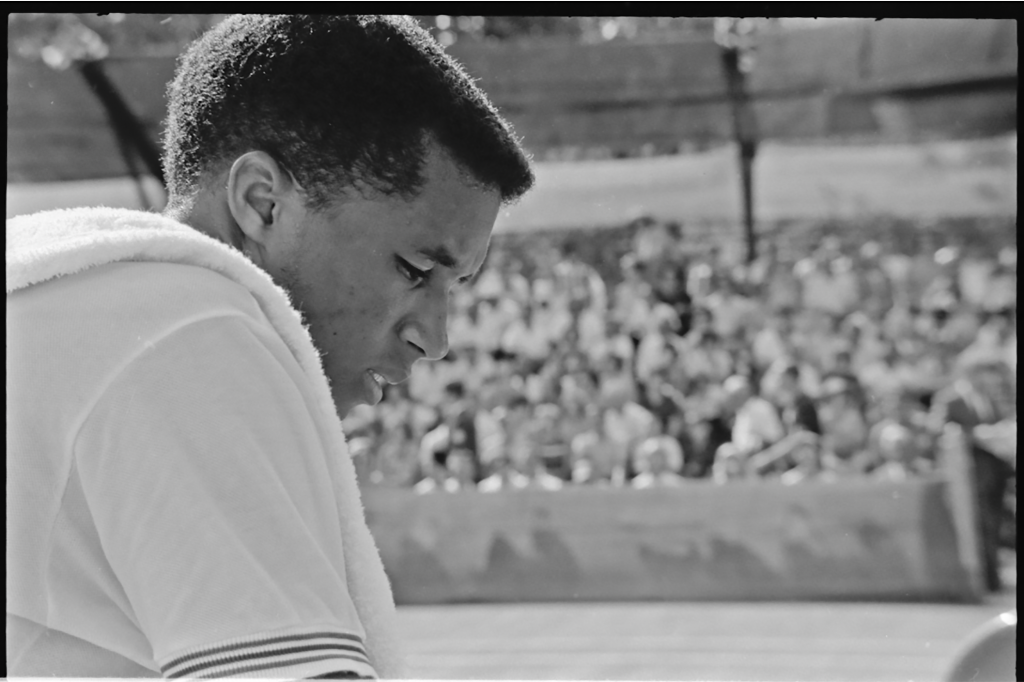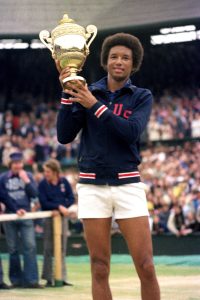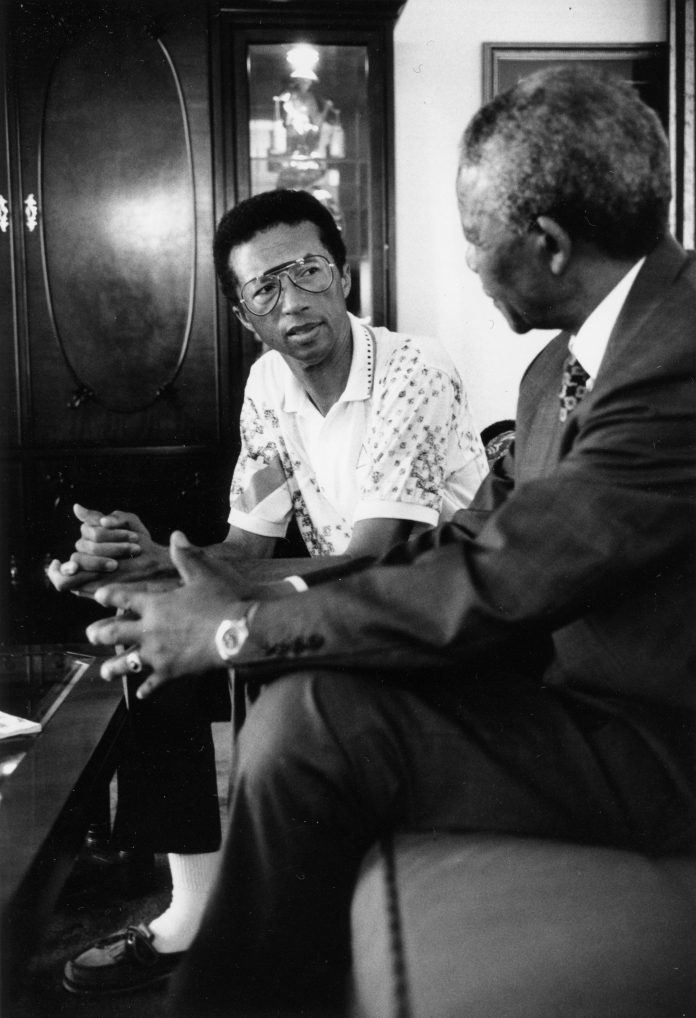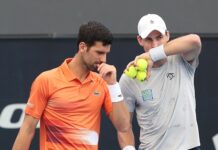Bill Simons
Their names have a similar ring – “King Richard” and “Citizen Ashe.” Movie makers rarely give us tennis films. Now, in just the past three weeks, two quite different movies made their in-theater debuts.
“King Richard” and “Citizen Ashe” focus on two of the most impactful men in tennis history. One film is the saga of the bigger-than-life patriarch Richard Williams, who, with fearless bluster and irrepressible determination, gave us Venus and Serena.
“Citizen Ashe” tells the story of Arthur Ashe, the disciplined, kind, cerebral athlete and restless thinker who helped bring down apartheid, who integrated men’s tennis, and who (thanks to his US Open, Wimbledon and Davis Cup wins) re-wrote the record book. Ashe’s gifts were wide-ranging. He was an ethereal and lethal player, a no-nonsense Davis Cup captain, a doting father, an author and a humanitarian like few others. A Renaissance man with an unyielding moral compass, he tirelessly combated racism and AIDS, and fought for education and that much maligned thing called reason.
The two movies are more different than an in-your-face overhead and a well-stroked topspin backhand winner. “King Richard” is a robust Hollywood biopic with superstar Will Smith and a brilliant cast, many rambunctious feel-good moments and provocative scenes that make us think. Bring your brain and your Kleenex.
Like Arthur himself, “Citizen Ashe” is more modest. It has plenty of details on his “Take that, Jimmy Connors!” tennis triumphs, and delves deep into his wisdom and genius. While “King Richard” has stars and French horns, “Citizen Ashe” puts to fine use the traditional tools of documentaries: vintage photos, newsreels, TV clips and interviews with his family and assorted sages.
It tells the story of a lean boy who grew up by a Richmond, Virginia park, with tennis courts just a few yards from his house. We’re reminded that Ashe’s beloved mother died when he was six and he was reared by a loving but fierce belt-wielding dad and trained by the don’t-shake-the-boat Dr. Walter Johnson, the tennis guru who guided so many African Americans.
We see how Ashe’s world opened up to dazzling new dimensions when he left behind the oppressiveness of the Jim Crow south and went west to swingin’ UCLA in the 60s.
“Citizen Ashe” gives us a five-set exploration of Ashe’s too short life. It shows us Arthur’s early conservative days (he voted for George Bush Sr.), his aversion to the rage and militancy of the Civil Rights Movement and his 1968 (“I can no longer sit on the sidelines”) conversion to activism. Ashe became an inspirational role model in Africa and a protester who was arrested in front of the White House while opposing the treatment of Haitian immigrants. He launched extraordinary initiatives for inner-city kids, for education, and against AIDS.
Now there’s a stadium that honors him. Essay contests are held in his name. Few other tennis players have two statues, a plaque, and assorted awards that honor their legacy.
Yet we forget.
Now “Citizen Ashe” gives us a great gift: an in-depth analysis of tennis’ noblest man, a thinker who loved to read, a problem solver who embraced so many diverse people, and a citizen who engaged our most critical issues.
Arthur was elegant and cool and had none of the bombast of Richard Williams. His theatricality was quiet, his charisma was gentle, his smiles didn’t show teeth. But he took a bite out of history. Amazingly, he was beloved both in corporate boardrooms and on the street. Programs he started still thrive.
When Nelson Mandela finally met him, the South African hero called out to him, “Arthur, Arthur, my brother.” The late Mayor David Dinkins said Ashe was “just a better human being than the rest of us.” A sublime performer in the arena and a conscious force that enriched so many, certainly Ashe and Billie Jean King were tennis’ greatest ambassadors.
Inside Tennis spoke with “Citizen Ashe” directors Rex Miller and Sam Pollard.
IT: In your wonderful movie, you speak of the chilling impact of the killing of Emmett Till in 1955. More recently, the George Floyd murder stirred international protest. If Arthur were here, would he more likely say, “Hey guys, some things just don’t change,” or would it be more like, “There has been some progress.”
POLLARD: He’d probably say, in his own Arthur Ashe way, sometimes things don’t change, but there has been some progress. He’d probably say things are still horrific in some ways, but there has been some momentum in changing and understanding racism in America.
MILLER: I’m a Southerner – I live in Durham, North Carolina…I don’t think Arthur would look back and talk about how far we’ve come. He’d ask, “What do we do next?” I don’t think anything that’s happened would have surprised Arthur, but I think he’d have been like, “We have more work to do. What are we going to do about it?”

IT: What would he say is next?
MILLER: He’d have actions to take, people to talk to and bring to the table. He was always very pragmatic. He was always bringing people together and everybody had a voice. [He’d say] we have to get someplace better together. He’d be very detail and action oriented – and he’d be calling people.
POLLARD: He’d try to have everybody express their perspective and view and to come to some sort of common ground. That’s the kind of man he was.
IT: Arthur had a gift of bringing both sides of the barricade together. He was comfortable in corporate boardrooms and the inner city. He embraced contradictions.
POLLARD: That comes from the fact that he was raised by a father who was a very strong disciplinarian. Arthur was told that if you’re going to make a point you have to figure out how to be articulate about it and express it. His father was a very controlled man and Arthur used that disciplinary control outside the tennis court, and when he fought apartheid.
When you look at his humanitarian efforts, his creating those tennis academies, and how he dealt with AIDS, he was very focused, very disciplined…[Early in his life] Arthur basically said, “I haven’t laid the groundwork yet to establish myself as a real tennis star, so I’m not ready to go out there and speak out.”
In the film, [militant sociologist] Harry Edwards says, “Well, this guy wasn’t going to break down any walls so I call him an Uncle Tom.” I understand that, but he learned.
Arthur was not monolithic. He had a different strategy, a different approach…which was going to be different from Muhammad Ali, Jim Brown or Bill Russell. He was going to be following a path more like Jackie Robinson.
IT: But then he changed.
MILLER: In regards to Arthur’s working within the system, one of the people his wife Jeanne Moutoussamy-Ashe compared him to was Althea Gibson, who was very solitary in her public life. Jeanne pointed out that Arthur grew up in Richmond, where he had the church around him for support and intellectual discourse. Then he went to UCLA and he represented them. So it was more than just the singular Arthur Ashe. Then he was in the military at West Point, and on the Davis Cup team. All these organizations stood behind him, giving him strength and a foundation.
On the opposite side, he had a lot of militants in the black power struggle telling him to be more militant, more militant: “Hey you’re an Uncle Tom.” So all of those forces combined to make Arthur do things his way, do things very pragmatically and systematically.
IT: It’s said that Arthur is the greatest man to emerge out of tennis. He had a bond with Nelson Mandela. Both loved tennis and, more importantly, both resisted becoming bitter. And of course there is that wonderful moment in the film where he says, “Arthur, Arthur – my brother.”
MILLER: That relationship was almost my favorite part of the whole film. In the mid-80s I was 23 and an aspiring photojournalist, and I spent a month hitchhiking around South Africa. There were protests going on. Mandela was still incarcerated. There was the white rule, there was a state of emergency. People were getting arrested left and right and I had to pull back, because it was no joke. So I was really struck by the South African relationship to Arthur.
One of the nuggets that we couldn’t put in the film was the South African player Ray Moore, who, early in the 60s, would have intellectual and political conversations with Ashe. He’d say, “Hey, Arthur, there is a black man in prison in my country and I think he’s going to be the first president and you should know about him.” And that set Arthur on a parallel path with Mandela. I spent a month in South Africa photographing and being an Ashe fan and a tennis guy myself. So, to me, that was always a really important part of the story.
IT: Some say Arthur’s greatest strength was his moral compass. He studied spirituality and meditation with Howard Thurman. He spoke about going into solitude and the power of grace. His book is called “Days of Grace.”
POLLARD: That was a little difficult for me. We all have a spiritual side. I’m not sure that Arthur…had a different sort of inner spirituality…He brought with him a certain zen calmness which you see in his bearing, his dialogues and interviews. Just to see his calm when he had his press conference when was outed for having AIDS.
Even though he was sweating a little, he was very disciplined, very zen-like in delivering the horrific news – and that speaks to a certain level of spirituality: “Here’s my life, how do I deal with it in a way that’s going to be more than just x’s and o’s or match point?”
Another section of the film that speaks to his discipline and focus is when he played Jimmy Connors at Wimbledon. That was phenomenal. Most of us, when we try to change our strategy and the other person figures out what the strategy is and starts pounding us, we revert back to the way we played. But Arthur was very focused and zen-like and stayed in the zone.
MILLER: That was one of the most fun parts of the movie and a way to get some nuance and nitty-gritty tennis stuff in. I still coach tennis and love to dissect it.
IT: Arthur was McEnroe’s Davis Cup captain. They were quite an odd couple. John was a young white star, and had no real problem in letting go with his explosions. But Arthur grew up in the South, when one misstep could get you into big trouble. He was envious of McEnroe’s emotional freedom – John could just let it all out.
POLLARD: Here is a young man who grows up in Richmond, Virginia, the capital of the Confederacy, where the statues of Robert E. Lee are all around the city, and Arthur is told, “Don’t make waves, don’t go out there, that’s not going to do.” We used to hear that when I was growing up: “That would hurt the race. That would get you killed.” My father and his brothers, who grew up in Mississippi, when they became young men, they all left Mississippi. Why? The racism – the fact that you could be murdered at any moment in the South.
It left an impact on them. So here’s Arthur Ashe, who is basically a man who wants to emulate Jackie Robinson, who comes up through the Brooklyn Dodgers, but he’s been told by [Dodger owner] Branch Rickey, “Don’t make waves. Let your bat do the talking.” So that’s who Arthur was. He was raised a certain way and he didn’t really take that away from himself…But after he won the US Open in ‘68, he had a platform to speak out.

IT: Arthur was an incredible intellect and gentleman who said he wanted to “disturb the comfortable and comfort the disturbed.” So was Ashe a radical?
POLLARD: He was radical but he was radical the Ashe way. He wasn’t radical. In athletics, when you say someone is radical you usually think of Muhammad Ali, Jim Brown and Bill Russell. Arthur wasn’t like those guys. He had a point to make, but he was going to do it the Ashe way. That was focus, discipline, wanting to bring people to the table, to hear all sides and to try to leave his imprint. And he knew by going to South Africa he was going to raise the hackles of certain black people who would say “Why, when the country is segregated, would you go there to play tennis?” But he wanted to see what it was like, and also to make sure that if he was going to play they had to desegregate that stadium. So he was radical – but in a different way.
MILLER: His South Africa trip disturbed a lot of people: a lot of white Americans, a lot of black South Africans, not to mention the white government in South Africa. And he really did it without blowing the whole place up. He was in a famous situation in South Africa, with all these black journalists, and a lot of them were attacking him: “Why did you come here? Why did you upset the government?” And he faced them at an intellectual level and a lot of them respected him after that. So that was his mode: “I’m going to go in and disturb the situation but not just for the sake of it. I have a purpose.” It was to help oppressed people everywhere, and being so pragmatic, he was always able to get past the emotional part of snubbing white South Africa.
He said, “Sure, I will go there and not talk about politics. I will only talk about tennis,” and people criticized him for that. But he was able to make a bigger impact because he had his mind on the long game.
IT: How is Arthur remembered these days? Has his legacy diminished?
MILLER: People forget the celebrities and sports stars of even just a few years ago. Do young people know who Joe Montana is? Stan Smith jokes about that all the time – some people think he’s a shoe. So it’s up to filmmakers like us and journalists like you to keep his memory alive and to bring his story out and show the relevance it has to what’s going on today. And, as [track star] Juan Carlos said, “Arthur never stopped thinking about his race – the human race.”
POLLARD: Arthur’s legacy is simply this: that he was not only a phenomenal player, but he was a phenomenal human being who cared about people and wanted to help people on all levels – from an economic perspective, from teaching young people to play tennis to his activism on apartheid. He was a phenomenal human being – simple as that. And “Citizen Ashe” gives an audience the opportunity to really see that.





















